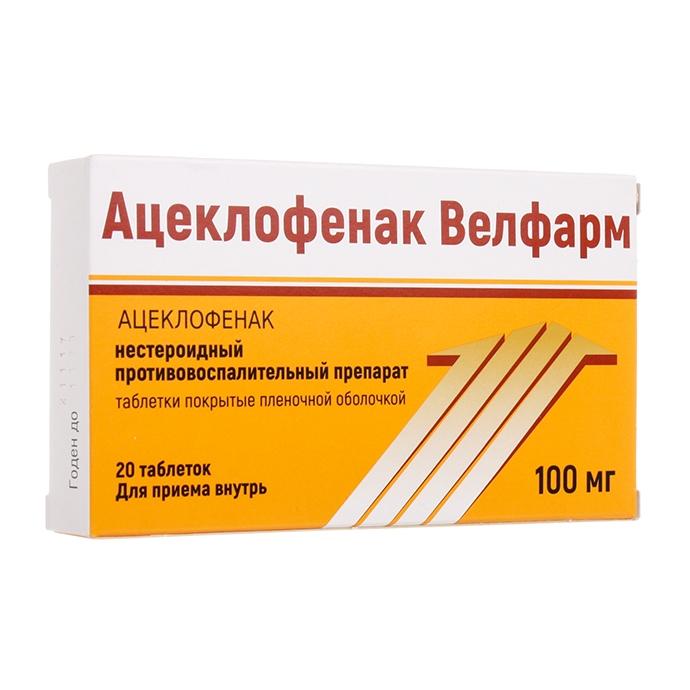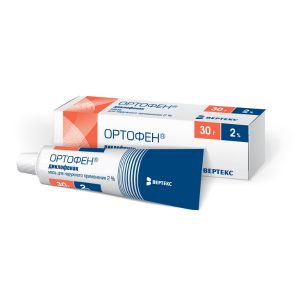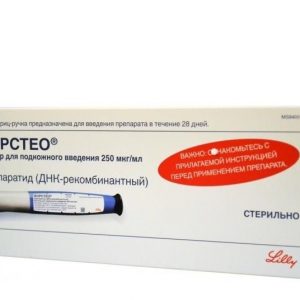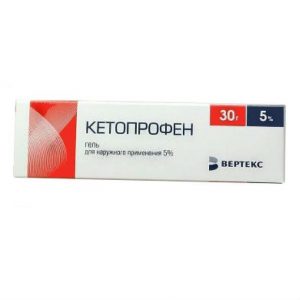Description
Pharmacological action of
Aceclofenac is a non-steroidal anti-inflammatory drug derived from phenylacetic acid. Aceclofenac has an analgesic, anti-inflammatory, antipyretic effect, which are associated with the inhibition of cyclooxygenase 1 and 2, which regulate the production of prostaglandins. When taken orally, aceclofenac is well absorbed. The maximum concentration is reached after 1.25 – 3 hours. Aceclofenac enters the joint fluid, where its content reaches 57% of plasma concentrations, and the time maximum concentration is reached 2 to 4 hours longer than in plasma. The distribution volume of aceclofenac is 25 liters. Aceclofenac binds to plasma proteins (albumin) by 99%. Aceclofenac circulates mainly unchanged, its main metabolite is 4 ‘ -hydroxyaceclofenac. the half-life is 4 hours. Aceclofenac is excreted by the kidneys, more than 60% in the form of hydroxy derivatives.
Indications
The drug is prescribed: as part of the complex treatment of inflammatory diseases of the musculoskeletal system (osteoarthritis, rheumatoid, psoriatic and juvenile arthritis, palsy, ankylosing spondylitis and spondylitis)
for the relief of pain in patients with rheumatoid arthritis and rheumatoid pain.
Aceclofenac is not able to completely cure these diseases, but it quickly reduces inflammation and pain.
Contraindications
The drug is contraindicated: for allergies to the active substance
to patients with ulcers and erosion in the digestive tract, during exacerbation of
with Crohn’s disease and ulcerative colitis
if there is a suspicion of bleeding from the gastrointestinal tract
for patients with impaired hematopoiesis or clotting disorders
during breastfeeding
with renal failure, hyperkalemia, progressive kidney disease
for children under 18 years old
during the recovery period after coronary artery bypass grafting
with the “aspirin triad”
for people suffering from severe heart failure.
Caution should be observed: for diseases of the kidneys, gastrointestinal tract and liver of moderate to mild severity
if the patient has the helicobacter bacterium in the gastrointestinal tract
with bronchial asthma
to persons with low blood pressure
after extensive operations, if
circulating blood volume is reduced during
ischemia, elderly
patients with cerebrovascular diseases
with diabetes mellitus
after prolonged treatment of NSAIDs
for alcoholics and smokers
in case of severe somatic diseases
in patients with red somatic disease , serotonin reuptake inhibitors, antiplatelet agents.
Ointment or cream should not be applied to damaged skin.
Use during pregnancy and lactation
An absolute contraindication to the use of the product is the 3rd trimester of pregnancy.
Special care must be taken in the 1st and 2nd trimesters and during breastfeeding. The medicine can be prescribed by a doctor in case of urgent need.
Special instructions
It is recommended to use minimally effective and active dosages as a precaution during treatment. Periodic monitoring of the liver and kidneys, a picture of peripheral blood, feces (lack of blood), and the work of the cardiovascular system are also shown.
During treatment, you must not drive or perform potentially hazardous activities.
The risk of allergies or skin reactions is higher in the first months of taking the medicine. If there are injuries of the oral mucosa, skin rashes, other signs of allergy, then therapy should be interrupted.
The process of inhibition of platelets during treatment with the drug is reversible, the composition of the blood normalizes some time after drug withdrawal.
Dosage and Administration
Tablets are prescribed by mouth. Depending on the disease and age of the patient, 100 to 200 mg of the drug per day is prescribed. 100 mg at a time, whole, without separation and without chewing, with a large amount of liquid.
Outwardly. The substance in the composition of the ointment or cream with a thin layer is carefully applied to the area of ​​inflammation 3 times a day. After using the drug, it is recommended to wash your hands thoroughly with soap, to prevent contact with eyes.
Side effects of
During Aceclofenac treatment, dizziness, nausea, abnormalities in the gastrointestinal tract, abdominal pain, indigestion, diarrhea
increase in liver enzyme activity, allergic reactions in the form of skin rashes and itching are often observed.
Less commonly developed: anemia, anaphylactic reactions, decreased visual acuity
increased blood pressure, heart failure, shortness of breath
increased concentration of creatinine and urea in the blood
constipation, oral ulcers, increased gas formation, gastritis, vomiting
gastric ulcer, melena, hemorrhoids
dermatitis, pruritus, Quincke’s edema, urticaria.
Very rare: muscle cramps, weakness and fatigue, weight gain, hyperkalemia, eczema
renal failure, nephrotic syndrome, purpura nephritis
, Stevens-Johnson syndrome, varicella infections of the soft tissue, toxic epidermal necrolysis of
granulocytopenia neutropenia, hematopoiesis, thrombocytopenia, hemolytic anemia
depression, vivid dreams and nightmares, sleep disturbances, vertigo, vasculitis
tremor, taste perversion, drowsiness, parestos sion, ringing in the ears
bowel perforation, pancreatitis, ulcerative colitis, vomiting blood
redness of skin, flushing, tachycardia
bronchospasm, stomatitis, hepatitis.
Drug Interactions
Anticoagulants when combined with tablets increase the risk of bleeding. During treatment, it is recommended to periodically monitor blood coagulation.
Aceclofenac tablets increase the plasma concentration of digoxin, phenytoin, and lithium-based drugs.
The substance when combined with antihypertensive drugs and diuretics reduces the effectiveness of the latter.
The combination of the drug with potassium-sparing diuretics increases the likelihood of hyperkalemia.
With caution, the drug should be combined with NSAIDs and glucocorticosteroids, the drug increases the toxicity of methotrexate and cyclosporine.
Aspirin reduces the plasma concentration of aceclofenac.
The combination of drugs with hypoglycemic drugs requires constant monitoring of blood glucose levels.
Overdose
There have been no reported cases of overdose in humans.
Overdose symptoms are: headaches, cramps, vomiting, abdominal pain, nausea, dizziness. Enterosorbents are used as therapy, they wash the stomach and produce symptomatic treatment. The drug does not have a specific antidote, hemodialysis and forced diuresis are ineffective.
Storage conditions
Tablets are stored in a cool, dark place, away from children.
The Expiration of
is 3 years.
Deystvuyuschee substances
Aceclofenac
Conditions of supply of pharmacies
prescription
Form of Treatment
tablets
Appointment
Adult prescribing children, Children older than 1699, children45 years old doctor, For athletes
Indications
sciatica, Rheumatoid arthritis, bruises, periarthritis, Edema after injuries and operations Arthritis, Osteoarthritis, Sciatica, Osteoarthritis, Lumbago
Possible product names
Aceclofenac Welfarm tablets coated. 100 mg 20 pcs.




